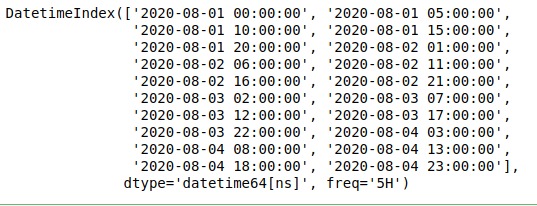此方法用于返回固定频率的DatetimeIndex,以工作日为默认频率。
用法:pandas.bdate_range(start=None, end=None, periods=None, freq=’B’, tz=None, normalize=True, name=None, weekmask=None, holidays=None, closed=None, **kwargs,)
参数:
- start:字符串或datetime-like,默认为None,左边界为生成日期。
- end:字符串或datetime-like,默认为None,用于生成日期的右边界。
- periods:整数,默认值无,要生成的周期数。
- freq: string或DateOffset,默认为“ B”(每日营业),频率字符串可以有多个,例如“ 5H”。
- tz:字符串或无,返回本地化的DatetimeIndex的时区名称,例如Asia /Beijing。
下面是上述方法的实现和一些示例:
范例1:
Python3
# importing packages
import pandas
# using pandas.bdate_range() method
print(pandas.bdate_range(start='8/1/2020',
end='8/20/2020'))输出:

范例2:
Python3
# importing packages
import pandas
# using pandas.bdate_range() method
print(pandas.bdate_range(start='8/1/2020',
end='8/5/2020',
freq='5H'))输出:

相关用法
- Python pandas.isna()用法及代码示例
- Python pandas.array()用法及代码示例
- Python pandas.eval()用法及代码示例
- Python pandas.crosstab()用法及代码示例
- Python pandas.lreshape()用法及代码示例
- Python pandas.merge_asof()用法及代码示例
- Python Pandas.set_option()用法及代码示例
- Python Pandas.get_option()用法及代码示例
- Python Pandas.reset_option()用法及代码示例
- Python Pandas.describe_option()用法及代码示例
- Python Pandas.cut()用法及代码示例
注:本文由纯净天空筛选整理自deepanshu_rustagi大神的英文原创作品 pandas.bdate_range() function in Python。非经特殊声明,原始代码版权归原作者所有,本译文未经允许或授权,请勿转载或复制。
